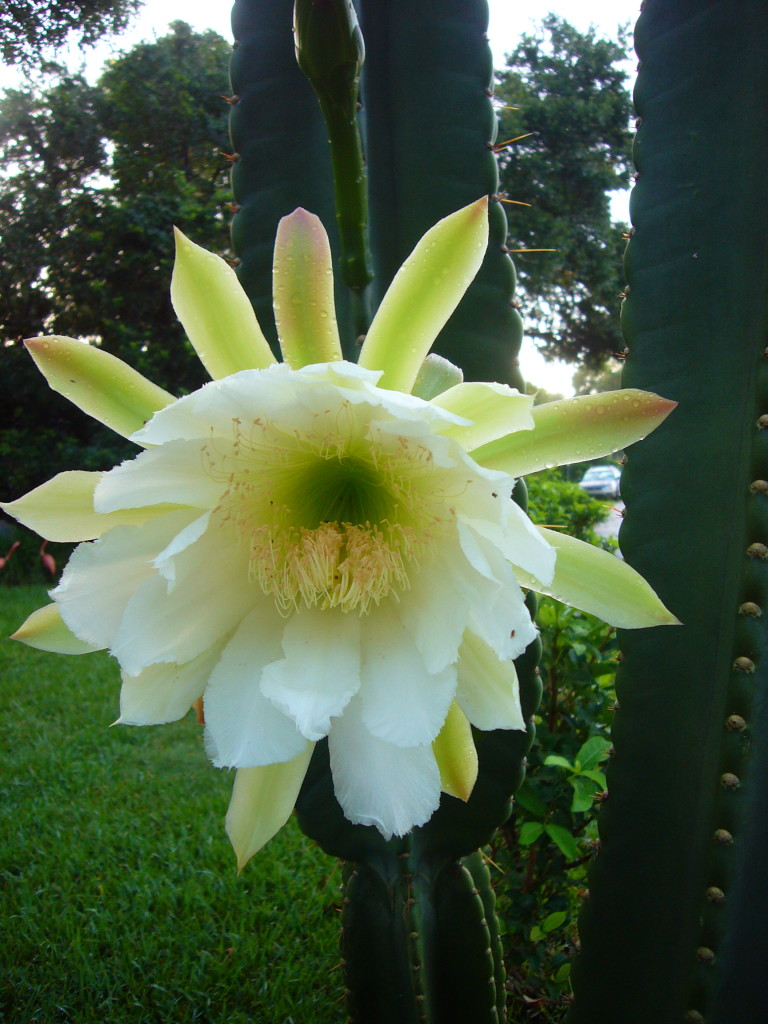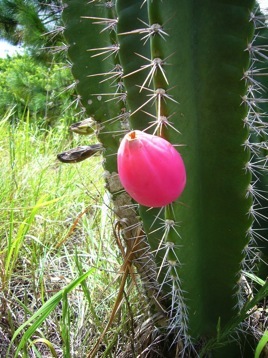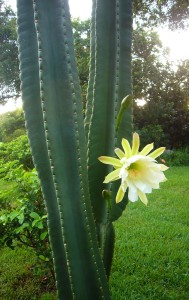Getting Down To Cereus Business
There are three things irritating about Cereus other than their spines: 1) several botanical names for the same plant; 2) which species do you exactly have, and 3) how you pronounce “Cereus.”
DNA testing may indeed be reducing crime but it is increasing cactuses, or at least changing their names. Many “cereus” are no longer cereus, among them C. undatus, C. pentagonus, C. robinii and C. keyensis, or as they are now known Hylocereus undatus, Acanthocerus tratragonus, Pilosocerus polygonus, and Pilosocereus robinii. Do those name changes clear things up? … Thought so….
The last three are found only in southern Florida or the Keys and are endangered. Just know they are sprawling, usually three sided, and fruit’s pulp is edible raw if you are starving, just spread the seeds around. Also endangered in Florida is the C. eriophorus var. fragrans, C. gracilis var aboriginum, C. simpsonii and C. deeringii. The H. undatus (aka C. triangularis & tricostatus) is naturalized up to coastal central Florida and planted inland, such as at Mead Gardens. It is a commercial crop called “Dragon Fruit.” Also eaten is Cereus giganteus, known more famously by its common name, Saguaro Cactus. (Now that Cereus is called Carnegiea gigantea.)
The fruit of cactus are used in similar ways. The Saguaro Cactus is a good example. It was a staple of the Papago and Pima Indians. They harvested the fruit in July. The fruit can be eaten fresh or dried. When dry they can be pressed into cakes. The juice was used to make moonshine and the seeds ground into a buttery paste. The fruits are also eaten of the C. hexagonus, C., jamacaru, C. pernambucensis, and the C. peruvianus, the latter is perhaps the most common ornamentally grown cactus in the world, if it really exists at all, as a species. An explanation is required.
While many cactus are sold with the name C. peruvianus some people aren’t even sure it really exists as a species and might actually be one or two other species, or some hybrid. The Cereus above has nine spines where as most pictures show them with seven. One Cereus with nine spines is C. jamacaru, but its fruit is oblong and the one above is not. Tis a puzzle. Fortunately, all Cereus fruits are all edible so which one you have is academic (though practical as some have spines and other do not.)
The pronunciation of the genus is also something of a puzzle. You can find SEE-ree-us (like serious.) Or KEE-ree-us, and one British plant dictionary even has KAY-ree-us, which is surprisingly linguistically the most accurate. Most sources cheat and say it comes from Latin or Latin and Greek. But they stop there. The original base word was κερἰ (keri) said ke-REE and means wax (think candle as in the shape which is why some call them candlestick cactus.) When the Romans took a Greek word beginning with a “K” they wrote it with a “C” which then often gets mangled into an “S” sound… KEE-ree to SEE-ree. As the plant is shaped like a candle the genus was called Cereus, so you can call it “SEE-ree-us or KEE-ree-us depending upon your Latin or Greek temperament though it is usually said SEE-ree-us. (Also see “Catus, don’t be spineless.”)
Green Deane’s “Itemized” Plant Profile
IDENTIFICATION: Stems creeping, sprawling or clambering, branching profusely, or straight up to 30 feet or more, thick; tough with age, wavy. One to three spines on adult branches , .5 to three inces long, grayish brown to black, spreading; skin deep green. Flowers large, night blooming, scented; greenish yellow or whitish, rarely tinged rose. Fruit oblong to oval, two to four inches long, one to two inches thick, red with large bracteoles, pulp white, seeds black.
TIME OF YEAR: Bloom and fruits mainly in August and September
ENVIRONMENT: Can be found on the ground or growing on trees and walls and the like
METHOD OF PREPARATION: Ripe fruit is often chilled and cut in half so that the flesh can be eaten with a spoon. The juice makes a cool drink. A syrup from the whole fruit can be used to color pastries and candy. The unopened flower bud can be cooked and eaten as a vegetable. The seeds can be eaten as is or ground up and used as flour. Fruits can also be made into preserves. Pulp food value is water, 92.20; protein, 0.48-0.50; carbohydrates, 4.33-4.98; fat, 0.17-0.18; fiber, 1.12; ash, 1.10%.




